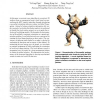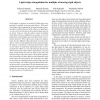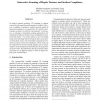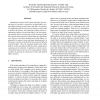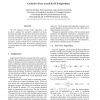106
click to vote
3DIM
2007
IEEE
15 years 7 months ago
2007
IEEE
Although a lot of effort already went into the development of 3D acquisition technology, and existing methods come of age, several challenges remain. We try to give a – probably...
111
Voted
3DIM
2007
IEEE
15 years 7 months ago
2007
IEEE
In this paper, we present a new algorithm to reconstruct 3D surfaces from an unorganized point cloud based on generalizing the MPU implicit algorithm through introducing a powerfu...
90
Voted
3DIM
2007
IEEE
15 years 7 months ago
2007
IEEE
In this paper, we propose an extension of light stripe triangulation for multiple of moving rigid objects. With traditional light stripe triangulation, the acquired shape of movin...
95
Voted
3DIM
2007
IEEE
15 years 7 months ago
2007
IEEE
We present an analytical method to estimate the absolute registration error bounds if two surfaces were to be aligned using the ICP (Iterative Closest Point) algorithm. The estima...
108
Voted
3DIM
2007
IEEE
15 years 7 months ago
2007
IEEE
This paper presents a new system for acquiring complete 3D surface models using a single structured light projector, a pair of planar mirrors, and one or more synchronized cameras...
109
click to vote
3DIM
2007
IEEE
15 years 7 months ago
2007
IEEE
In modern computer graphics, 3D scanning is common practise for the acquisition of the geometry of objects. However, in addition to geometric models, physical models of interactio...
116
Voted
3DIM
2007
IEEE
15 years 7 months ago
2007
IEEE
Laser scanner measurements are corrupted by noise and artifacts that can undermine the performance of registration, segmentation, surface reconstruction, recognition, and other al...
3DIM
2007
IEEE
15 years 7 months ago
2007
IEEE
Simultaneous capture of the texture and shape of a moving object in real time is expected to be applicable to various fields including virtual reality and object recognition. Two...
122
click to vote
3DIM
2007
IEEE
15 years 7 months ago
2007
IEEE
The ICP (Iterative Closest Point) algorithm is the de facto standard for geometric alignment of threedimensional models when an initial relative pose estimate is available. The ba...
3DIM
2007
IEEE
15 years 7 months ago
2007
IEEE
Generating free-viewpoint video in outdoor sports environments is currently an unsolved problem due to difficulties in obtaining accurate background segmentation and camera calib...

